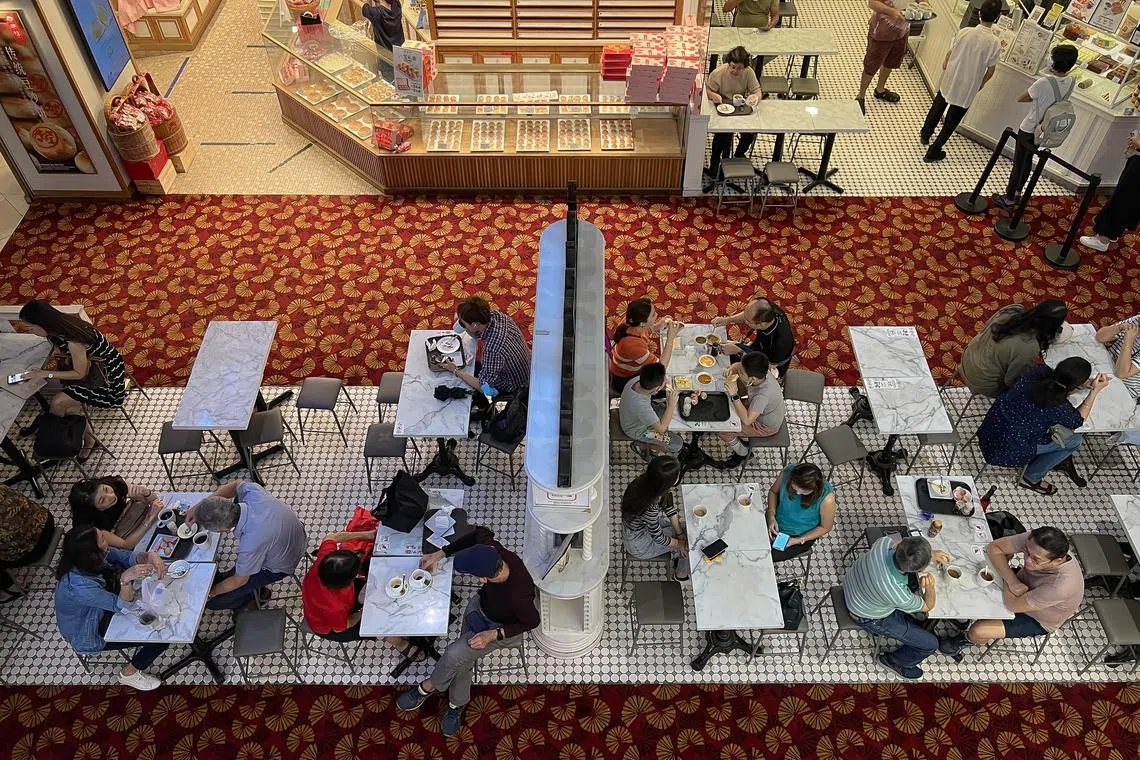More patrons dining out as F&B sector reopens fully, but customer satisfaction dips
Sign up now: Get ST's newsletters delivered to your inbox

Overall, 59.4 per cent of customers surveyed said they had most recently dined out.
ST PHOTO: GAVIN FOO
Follow topic:
SINGAPORE - More people are dining out now than in 2021, but fast-food outlets and restaurants are falling short in terms of customer satisfaction and perceived quality of products and services such as takeaway and food delivery.
The findings were part of a Customer Satisfaction Index of Singapore survey, whose results were released on Friday.
The annual survey by the Institute of Service Excellence (ISE) at the Singapore Management University assesses consumer attitudes towards the food and beverage, and tourism sectors.
A total of 2,600 people were surveyed online in 2022 between July and September.
With the easing of pandemic restrictions,
Respondents who chose to dine out for meals went up from 46.4 per cent to 74.2 per cent at restaurants; from 21.5 per cent to 44.7 per cent at fast-food restaurants; and from 35 per cent to 52 per cent at cafes and coffee houses.
But across the board, customer satisfaction – measured on a scale of 0 to 100 – dropped year on year for fast-food restaurants by 2.8 per cent to 71.9 points; and for restaurants by 1.9 per cent to 71.6 points. Cafes and coffee houses, on the other hand, saw a slight increase by 1.5 per cent to 70.6 points.
Respondents were also asked if they dined out, took home or ordered food delivery for their most recent meal.
Compared with 2021, restaurants, in particular, were given the thumbs down in terms of quality of the dine-in, takeaway and food delivery experience. Their perceived quality score took a hit, falling 3.4 per cent year on year to 74.4 points., owing largely to dissatisfaction with takeaway.
Issues raised by respondents included poorer ordering and process experiences such as approachability of staff, than when they dined in, or ordered food via a delivery platform.
Overall, respondents were also less satisfied with food delivery platforms.
Fewer respondents ordered food through delivery platforms in 2022 than in 2021.
At cafes and coffee houses, for instance, people who ordered items through food delivery platforms, such as GrabFood, foodpanda and Deliveroo, fell significantly from 98.8 per cent to 72.2 per cent.
Perceived quality and value contributes to satisfaction among consumers, which in turn contributes to factors such as customer loyalty, higher repurchasing behaviour and customer referrals.
ISE executive director Neeta Lachmandas noted that while F&B businesses have rebounded strongly following Singapore’s full reopening, they are still in a transition period where they are figuring out how best to allocate resources.
Ms Neeta said: “F&B and tourism operators have to deal with higher numbers and they are trying to manage processes. With everything ramped up back to 100 per cent, as compared to last year, restaurant owners are going through a period where they are trying to rebalance.
“Their resources are finite and with dine-in getting busier.... they will have to figure out where and how to best allocate resources.”
However, while takeaways have proven to be a viable revenue stream for F&B establishments as a direct result of the pandemic, factors such as significant manpower challenges
“This year, there was a movement down in customer satisfaction, so businesses will have to pay attention to some of the areas where they have seen significant drops in satisfaction.”
On the tourism front, Singapore’s tourist attractions scored 74.1 points in terms of customer satisfaction, a 1.7 per cent dip year on year.
In 2022, the study measured only local visitors as surveys were conducted while tourist arrival figures were still low.
However, tourist arrival numbers are on track to close the year at the higher end of an earlier Singapore Tourism Board forecast of four million to six million visitors in 2022.
There were 4.5 million visitors to Singapore in the first 10 months of 2022, or around 40 per cent of pre-Covid-19 levels.
The study found a notable increase in the older visitors segment, where the proportion of visitors aged 50 and above rose 4.9 percentage points year on year to 28.6 per cent.
However, this segment had a lower perceived service quality score of 73.6 points than that of younger visitors aged between 18 and 29, whose score was 78.3 points. Factors such as entertainment and educational value of the attraction, staff knowledge and clarity of directions within the attractions were found to be contributing factors for this lower perception of quality.
“With travel restarting at a brisk pace and expectations for the healthy return of visitors to attractions, it will be essential for operators to identify the needs and desires of potentially new groups of customers, seize the momentum, and build the buzz that will drive positive word-of-mouth and return visits,” said Ms Neeta.


